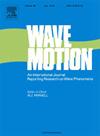含流体裂缝介质中波传播的室内和数值实验
IF 2.5
3区 物理与天体物理
Q2 ACOUSTICS
引用次数: 0
摘要
了解裂缝和流体如何影响弹性波传播仍然是一个复杂的难题,这推动了对裂缝介质中流体性质与纵波传播之间关系的探索。从纵波记录中解开流体粘度和密度仍然存在挑战,文献并没有提供明确的答案。因此,我们进行了实验室和数值实验,以检验当用线性滑移模型解释裂缝时流体粘度和密度对纵波传播的影响。介质由具有平行水平裂缝的叠铝盘组成。我们考虑1、5、10条裂缝,采用水、硅油、蜂蜜作为填充材料。在实验室中,我们得到了平行充液裂缝的静、动、法向和切向顺应度。采用不连续伽辽金方法进行了数值模拟,并结合了从实验中获得的动态柔度。实验结果表明,流体密度与纵波速度、透射系数和质量因子呈正相关。此外,与骨折数量呈负相关。在干、饱和条件下,正切向裂缝柔度及其比值随裂缝数量的增加而减小。静态遵从性通常高于动态遵从性。数值结果在区分不同流体方面表现出良好的一致性,尽管与实验观测相比,数值衰减略显低估。研究结果强调了流体性质对裂缝介质中波动行为的影响,并为裂缝特征的波动敏感性提供了见解。本文章由计算机程序翻译,如有差异,请以英文原文为准。
Laboratory and numerical experiments of wave propagation in media with fluid-filled fractures
Understanding how fractures and fluids can influence elastic-wave propagation remains a complex puzzle, driving the exploration of the relationship between fluid properties and P-wave propagation through fractured media. Unraveling fluid viscosity and density from P-wave recordings still poses challenges, and the literature does not provide univocal answers. Therefore, we conduct both laboratory and numerical experiments to examine the effects of fluid viscosity and density on P-wave propagation when fractures are interpreted in terms of the linear-slip model. The medium consists of stacked aluminum discs with parallel horizontal fractures. We consider 1, 5 and 10 fractures and use water, silicone oil and honey as infill materials. In the laboratory, we obtain the static and dynamic, normal and tangential compliances of parallel fluid-filled fractures. We performed numerical simulations using the discontinuous Galerkin method, incorporating the dynamic compliances obtained from the experiments. Our laboratory findings indicate that fluid density correlates positively with P-wave velocity, transmission coefficient, and quality factor. Furthermore, there is an inverse correlation with the number of fractures. In addition, the normal and tangential fracture compliances and their ratio vary between dry and saturated conditions and decrease when the number of fractures increases. The static compliance is, in general, higher than the dynamic. The numerical results showed good agreement in discriminating between different fluids, although numerical attenuation was slightly underestimated compared to experimental observations. The results highlight the impact of fluid properties on wave behavior in fractured media and provide insights into wave sensitivity to fracture characteristics.
求助全文
通过发布文献求助,成功后即可免费获取论文全文。
去求助
来源期刊

Wave Motion
物理-力学
CiteScore
4.10
自引率
8.30%
发文量
118
审稿时长
3 months
期刊介绍:
Wave Motion is devoted to the cross fertilization of ideas, and to stimulating interaction between workers in various research areas in which wave propagation phenomena play a dominant role. The description and analysis of wave propagation phenomena provides a unifying thread connecting diverse areas of engineering and the physical sciences such as acoustics, optics, geophysics, seismology, electromagnetic theory, solid and fluid mechanics.
The journal publishes papers on analytical, numerical and experimental methods. Papers that address fundamentally new topics in wave phenomena or develop wave propagation methods for solving direct and inverse problems are of interest to the journal.
 求助内容:
求助内容: 应助结果提醒方式:
应助结果提醒方式:


